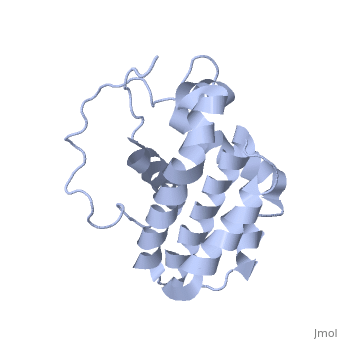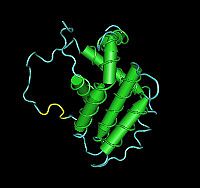B-cell lymphoma proteins (Bcl) family are pro-survival proteins or apoptosis regulators.
- Bcl-2 and Bcl-xL suppress cell death.
- Bak or Bcl-2-like-7 or Bcl-2 homologous antagonist/killer and Bax or Bcl-2-like-4 promote apoptosis
- .Bcl-xL (Bcl-2-like protein 1) known as survival protein is the regulator of apoptosis.
- Mcl-1 is an induced myeloid cell leukemia differentiation protein.
- Bcl-2-like-11 is called Bim.
BH3 domain is a Bcl-2 homology 3 domain present in Bcl-2 protein family.
For Bcl-6 see also BCL6 (Hebrew)
Overview
Bcl-2 is a family of genes and proteins that govern the mitochondrial membrane permeabilization (MMP). Bcl-2 derives its name from B-cell lymphoma 2 which came from being the second member of a range of proteins initially described as a reciprocal gene translocation in chromosomes 14 and 18 in follicular lymphomas. The genes and proteins can be either pro-apoptotic (Bax, BAD, Bak and Bok) or anti-apoptotic (Bcl-2, Bcl-xL, and Bcl-w). These genes interact with the Bcl-2 protein structure, which result in either a pro- or anti-apoptosis function. The sites on Bcl-2 where the genes interact, have been characterized by Dr. JC Reed et al[2]. These domains are , , and . Dr. Reed found that any deletion of these domains, abolishes Bcl-2's ability to suppress cell death.
Apoptosis is the programmed death of cells. It is central to the development and homeostasis of multicellular organisms, and it is the route by which unwanted or harmful cells are eliminated from the organism. The mitochondria is a large contributor in the subcellular partitioning of the apoptotic activator molecules such as cytochrome c. There are several triggering agents such as Ca2+, reactive oxygen species, certain lipid molecules and certain protein kinases that can induce MMP. The interaction opens the protein permeable pores that allow the release of several proteins including cytochrome c, Smac/Diablo, AIF, Endonuclease G, etc. Depending on their activated function, Bcl-2 either promotes the release or sequesters the function of the specific proteins.
See also Fragment-Based Drug Discovery.
Cancer
Bcl-2 is involved in a number of cancers. These include melanoma, breast, prostate, and lung carcinomas. It is also known to have involvement in schizophrenia as well as autoimmunity.
Experiment
Research from Dr. Mee Young Hong, et al has shown that dietary fish oil is protective against colon tumorigenesis[1]. However the mechanism by which this regulation is taking place is not well understood. Dr. Hong’s group hypothesized that dietary fish oil increases apoptosis by down regulating bcl-2 expression. Rat tissues were prepared by acclimating the rats for 1 week, providing an experimental diet for 2 weeks and injecting the rats with a colon carcinogen and then terminating the rats at 3, 6, 9 and 12 hours later. The experimental diets only differed in the fat composition. The first diet used corn oil while the second diet used fish oil. The main constitutional differences between the two oils were significantly higher amounts of EPA and DHA in the fish oil compared to the corn oil and higher concentration of n-6 in the corn oil. The corn oil was also chosen because it contains linoleic acid, which is known to promote colon tumorigenesis.
Bcl-2 was analyzed using quantitative immunohistochemistry (IHC) and also immunoblot analysis.
IHC is the process of localizing proteins in tissues by exploiting the principle of antibodies binding specifically to antigens. The visualization of the antibody is commonly accomplished by conjugating an enzyme to the antibody. This can produce a color changing reaction. The advantage of this method is the ability to show exactly where a given protein is located. Twenty column crypts were analyzed for each animal. The images of the crypts were visualized using a light microscope, captured on a digital camera and analyzed using NIH software.
Conclusions
Bcl-2 decreases in expression until 9h post carcinogenic injection in both the proximal and distal colon. This corresponds to an apoptotic index peak at 9h in both the proximal and distal colon.
Fish oil feeding resulted in lower levels of bcl-2 at the upper third of the crypt in the distal colon compared with corn oil feeding. Fish oil feeding doubled the apoptotic index compared with corn oil feeding in the upper third crypts in the distal colon.
3D structures of B-cell lymphoma proteins
B-cell lymphoma proteins 3D structures



